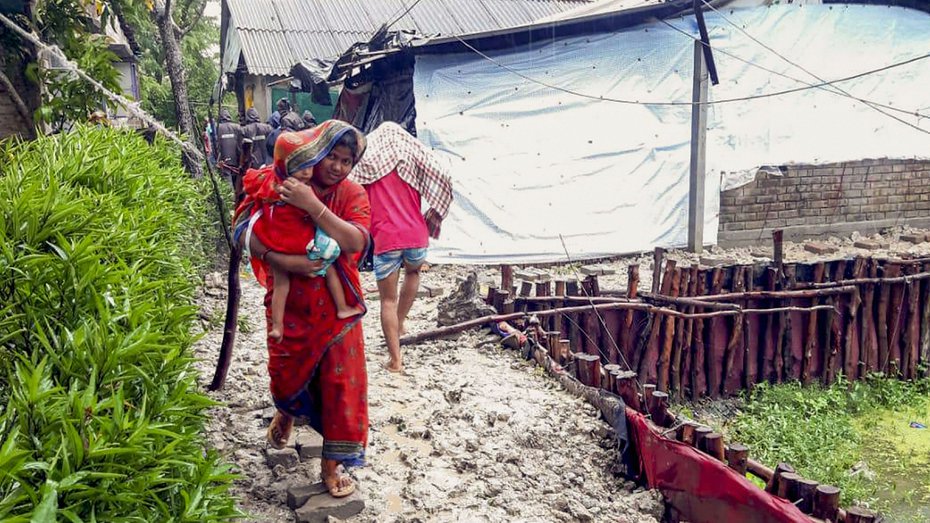Crises bring us to a crossroads. We have the choice to either do things that were not considered earlier or were not thought to be possible, or we can try and get back to the ‘before’. Every time a cyclone hits the Sunderbans we are faced with a crisis. On each occasion, we have tried to get back to where we were prior to the incident. This has been the practice since the 19th century. It is, therefore, unsurprising that incidence of poverty and development deficit are high in the region.
The Sunderbans region is predominantly agricultural, but prospects of farming are poor owing to low irrigation intensity and cropping intensity. Consequently, economic necessity drives working adults to seek earnings elsewhere. The current situation is a reminder that disasters like pandemics and cyclones do not necessarily arrive one at a time, and can constrain possibilities of earnings from outside.
Images from the Sunderbans post Cyclone Amphan are near identical to those after Cyclone Aila. Has nothing changed in the intervening decade? Of course it has; road connectivity is better and telecommunication has improved but vulnerability to tropical cyclones remains unchanged. It will remain the same so long as people live in kutcha houses and engage in freshwater paddy agriculture.
Storm damage will be much less if all houses are pucca. Storm surge damage can be significantly lower if the entire length of embankments is of superior design and construction. The irrigation and waterways department of the government of West Bengal is engaged in such construction under Phase I of Aila embankment reconstruction.
Besides political will, what would it take to make pucca houses and superior embankments?
As per the census of 2011, the Sunderbans has 8,84,073 households. At the least 5,30,444 are kutcha houses. The socio-economic and caste census 2011 pegs the proportion of impermanent houses in West Bengal at 60 per cent. All these houses can be pucca if the households take advantage of the Pradhan Mantri Awas Yojana — Gramin programme under which assistance of Rs 1.2 lakh is extended per household. The governments at the Centre and in the state would have to bear about Rs 6,365 crore on a 60:40 basis. For the state government, that works out to Rs 2,546 crore, plus allocation of public land for the landless households.
The IWD maintains about 3,221 kilometres of embankment in the Sunderbans. About 183 kms length of embankment has been upgraded or is underway at a cost of Rs 1,339.50 crore. At this rate, upgrading the entire length of embankment would cost about Rs 23,600 crore. The Government of India had approved Rs 5,032 crore for 778 kms in 2010. That leaves Rs 18,568 crore to be mobilized by the state government.
A World Bank report published in 2014 estimated the GDP of the Sunderbans to be around Rs 13,400 crore.
Although there is strong local support for both the interventions, it does not seem very likely that the governments at the Centre and in the state will commit to incurring a combined expenditure of about Rs 30,000 crore owing to associated political risk. Political risk arises from distributional and allocation impacts of large-scale spending on coastal protection when the area afforded protection is not an economic power house or highly built-up or urbanized. Allocation and distributional concerns arise when distant taxpayers believe that they are unfairly burdened by allocation of costs of proposed coastal protection measures. Moreover, engineered protective structures while providing protection to lives and assets behind the structure have the potential to increase risk to other areas and structures along the coast. The only mangrove tiger habitat in the world is a case in point.
What option, then, do the people of the Sunderbans and governments have in light of increasing climate risk? Move people and assets out of harm’s way — retreat. Retreat already occurs in the Sunderbans; homes, schools and places of worship are moved as an ad hoc measure to reduce risk.
Retreat can be reconceptualized not as a goal in itself to reduce risk but as a means to achieving long-term development goals. Jayanta Bandyopadhyay, formerly with IIM Calcutta, in a conversation with the author a decade ago had conceptualized retreat as a voluntary movement of people to safer locations in pursuit of a better life. That conversation resulted in a WWF-India publication with the title Indian Sundarbans Delta — A Vision in 2011. Bangladesh seems to be pursuing a path as envisaged in the vision document.
Bangladesh is working to not only make recipient cities like Khulna, Rajshahi, Satkhira, Barishal and Sirajganj capable of accommodating internal migrants through the strengthening of administrative structures but also offering climate migrants income-generating opportunities and assistance to improve their access to public social services and finances.
In India, it is for us to decide whether we want yet another serious crisis to go to waste.











